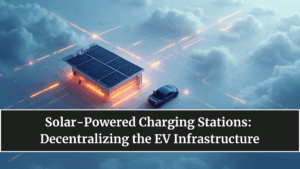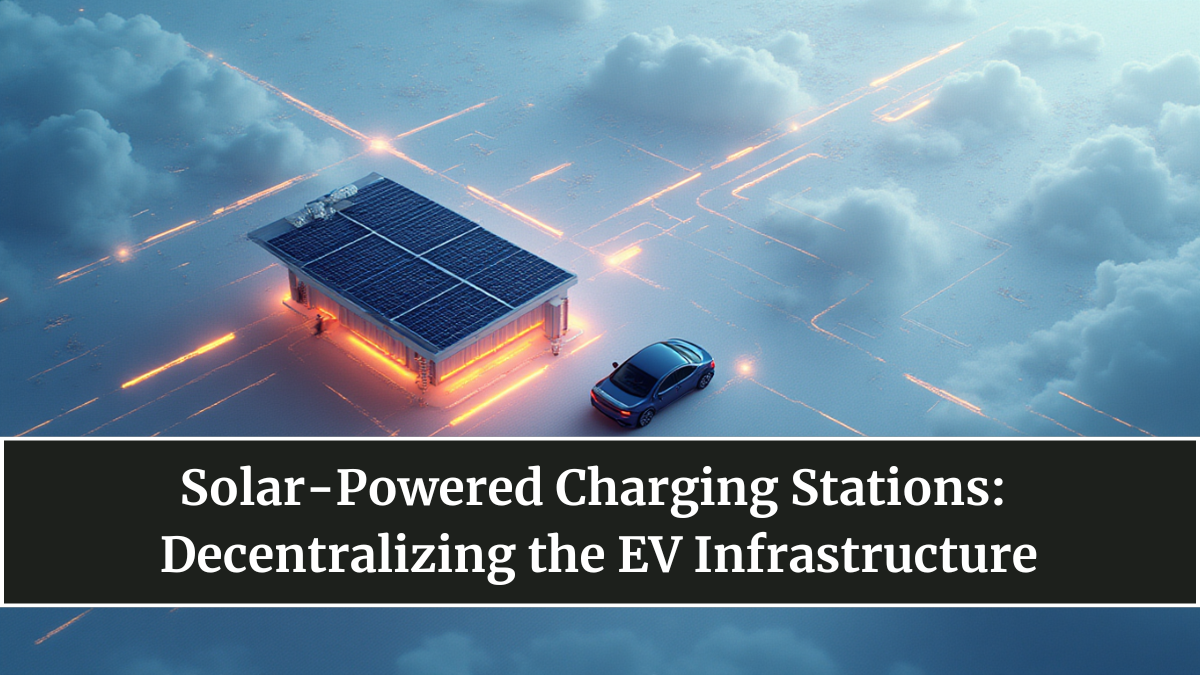The global electric vehicle revolution is now being powered by the sun. In 2025, solar-powered charging stations are emerging as the backbone of sustainable mobility — offering clean, decentralized, and cost-efficient energy solutions. With rising EV adoption, these solar charging hubs are helping reduce grid dependence and making EV ownership truly green and self-reliant.

How Solar EV Charging Works
At its core, solar EV charging 2025 combines photovoltaic (PV) panels with smart energy management systems to store and deliver electricity to electric vehicles. Solar panels capture sunlight, convert it into DC electricity, and channel it to battery banks or directly to charging points.
Advanced systems even integrate AI-based energy distribution to optimize when to draw from solar storage or the grid. Many setups include bi-directional charging, allowing vehicles to send energy back to the grid during low-demand periods — a concept known as vehicle-to-grid (V2G).
This creates a closed-loop energy cycle that’s clean, efficient, and self-sustaining, reducing reliance on fossil fuels.
Why Solar Charging Is the Future of EV Infrastructure
Traditional charging networks rely heavily on grid electricity, which is often generated from non-renewable sources. Solar-powered stations, on the other hand, use abundant natural sunlight, offering both economic and environmental benefits.
Key advantages include:
-
Zero operating emissions – 100% clean energy from the sun.
-
Lower long-term costs – Once installed, solar systems significantly reduce electricity expenses.
-
Energy independence – EV owners can charge anywhere with minimal infrastructure support.
-
Scalability – Modular systems can be expanded as EV usage increases.
For countries with high solar potential like India, the UAE, and Australia, these charging stations are becoming a crucial component of the national EV roadmap.
Global Adoption and Government Support
Governments worldwide are recognizing the importance of solar-integrated EV charging. In 2025:
-
India is developing over 22,000 solar EV stations under the National Solar Mission.
-
The US Department of Energy is co-funding large-scale solar-powered rest stops and highways.
-
European nations are combining EV incentives with renewable energy credits for solar charging setups.
Even private companies such as Tesla, Tata Power, Shell Recharge, and BP Pulse are investing in solar-based networks, integrating storage batteries and real-time monitoring through IoT and cloud analytics.
Integration with Smart Cities and AI
Solar EV charging is becoming a key element of smart city ecosystems. Connected grids use AI and IoT to manage demand, track solar output, and coordinate vehicle charging schedules.
For example, AI-powered platforms can predict peak sunlight hours, adjust energy loads, and even direct surplus power to nearby buildings or public lighting. This synergy enhances urban energy efficiency while supporting a circular green economy.
Moreover, blockchain technology is now being used to record solar energy transactions securely, ensuring transparent carbon credit management.
Overcoming Challenges and Scaling Adoption
Despite rapid progress, some challenges remain. Weather dependency, upfront installation costs, and space constraints in dense urban areas can limit deployment. However, innovation is catching up fast:
-
Solar carports and rooftop installations maximize space efficiency.
-
Portable micro-chargers enable off-grid rural charging.
-
Hybrid solar-grid systems ensure uninterrupted power supply.
These developments make solar charging a viable and reliable alternative even in regions with inconsistent weather conditions.
The Road Ahead
As the world accelerates toward full electrification, solar-powered charging stations will define the next stage of the EV revolution. By combining renewable energy with advanced digital control, they promise a decentralized, resilient, and cost-effective charging network for the future.
In the coming years, expect highways lined with solar canopies, cities powered by renewable grids, and vehicles charging seamlessly from the sun — marking the beginning of a true green mobility era.
FAQs
What is a solar-powered EV charging station?
It’s a charging setup that uses solar panels to generate and store electricity for charging electric vehicles, reducing reliance on the power grid.
Are solar EV chargers cost-effective?
Yes. Although installation costs are higher initially, operational costs are minimal, and long-term savings on electricity are significant.
Can solar charging work at night?
Yes, through battery storage systems that store daytime solar energy for nighttime use.
Which countries are leading in solar EV charging?
India, the US, Germany, and Australia are rapidly expanding their solar EV charging networks.
What is the future of solar EV infrastructure?
The future lies in smart, decentralized networks powered by renewable energy, AI-based management, and widespread solar integration.
